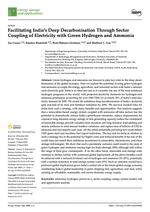Analysis of properties of the global trade network has generated new insights into the patterns of economic development across countries. The Economic Complexity Index (ECI), in particular, has been successful at explaining cross-country differences in GDP/capita and economic growth. The ECI aims to infer information about countries productive capabilities by making relative comparisons across countries’ export baskets. However, there has been some confusion about how the ECI works: previous studies compared the ECI to the number of exports that a country has revealed comparative advantage in (‘diversity’) and to eigenvector centrality. This paper shows that the ECI is, in fact, equivalent to a spectral clustering algorithm, which partitions a similarity graph into two parts.
A new interpretation of the Economic Complexity Index
04 February 2018
Other Recent Journal Article / Working Papers

Water temperature regulations could help to balance biodiversity and energy security

An aspirational approach to planetary futures

Resolving Uncertainties in the Legality of Wildlife Trade to Support Better Outcomes for Wildlife and People

Protect the Integrity of CITES: Lessons From Japan's IWC Withdrawal to Keep Polarization From Tearing CITES Apart
Controlled Catalysis Delivering High Molecular Weight Polyesters as Recyclable Alternatives to Polystyrenes

Facilitating India’s Deep Decarbonisation Through Sector Coupling of Electricity with Green Hydrogen and Ammonia